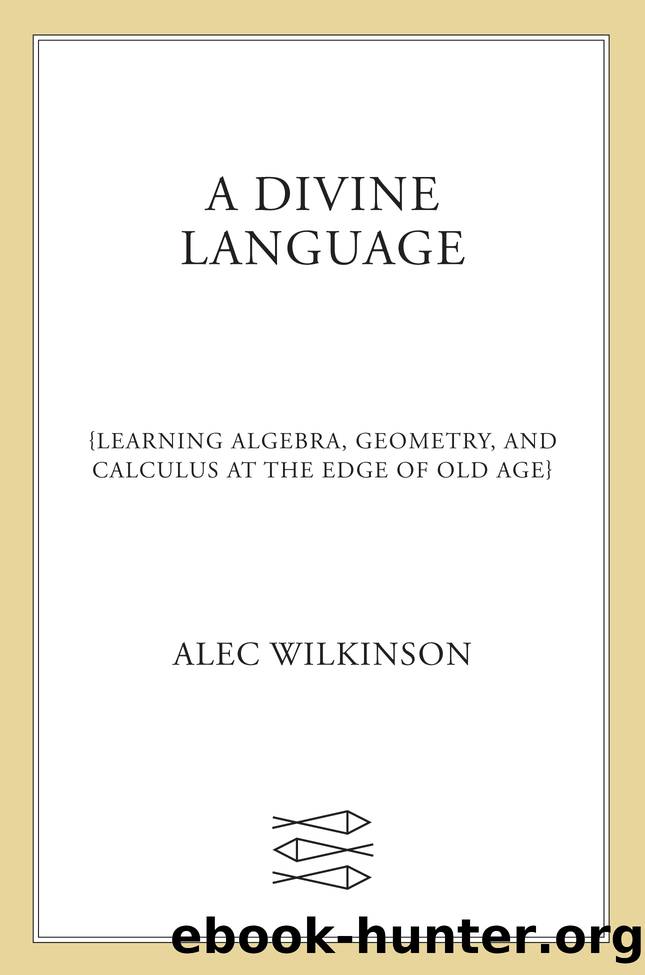A Divine Language: Learning Algebra, Geometry, and Calculus at the Edge of Old Age by Alec Wilkinson

Author:Alec Wilkinson [Wilkinson, Alec]
Language: eng
Format: epub
Tags: Biography & Autobiography, Personal Memoirs, mathematics, History & Philosophy
ISBN: 9781250168580
Google: EK09EAAAQBAJ
Publisher: FarrarStraus
Published: 2022-07-12T21:26:17+00:00
11.
âBounded Gaps Between Primesâ is a backdoor attack on the twin-prime conjecture, which was proposed in the nineteenth century and says that, no matter how far you travel on the number line, even as the gap widens between primes, you will always encounter a pair of primes that are separated by two, such as 5 and 7. The twin-prime conjecture is still unsolved. Zhang established that there is a distance within which, on an infinite number of occasions, there will always be two primes.
âYou have to imagine this coming from nothing,â Eric Grinberg said. âWe simply didnât know. It is like thinking that the universe is infinite, unbounded, and finding it has an end somewhere.â Picture it as a ruler that might be applied to the number line. Zhang chose a ruler of a length of seventy million, because a number that large made it easier to prove his conjecture. (If he had been able to prove the twin-prime conjecture, the number for the ruler would have been two.) This ruler can be moved along the line of numbers and enclose two primes an infinite number of times. Something that holds for infinitely many numbers does not necessarily hold for all. For example, an infinite number of numbers are even, but an infinite number of numbers are not even, because they are odd. Similarly, this ruler can also be moved along the line of numbers an infinite number of times and not enclose two primes.
From Zhangâs result, a deduction can be made, which is that there is a number smaller than seventy million which precisely defines a gap separating an infinite number of pairs of primes. You deduce this, Amie told me, by means of the pigeonhole principle. You have an infinite number of pigeons, which are pairs of primes, and you have seventy million holes. There is a hole for primes separated by two, by three, and so on. Each pigeon goes in a hole. Eventually, one hole will have an infinite number of pigeons. It isnât possible to know which one. There may even be many, there may be seventy million, but at least one hole will have an infinite number of pigeons.
Having discovered that there is a gap, Zhang wasnât interested in finding the smallest number defining the gap. This was work that he regarded as a mere technical problem, a type of manual laborââambulance chasingâ is what a prominent mathematician called it. Nevertheless, within a week of Zhangâs announcement mathematicians around the world began competing to find the lowest number. One of the observers of their activity was Terence Tao, who had the idea for a cooperative project in which mathematicians would work to lower the number rather than âfighting to snatch the lead,â he told me.
The project, called Polymath8, started in March of 2013 and continued for about a year. Incrementally, relying also on work by a young British mathematician named James Maynard, the participants reduced the bound to 246. âThere are several problems with going lower,â Tao said.
Download
This site does not store any files on its server. We only index and link to content provided by other sites. Please contact the content providers to delete copyright contents if any and email us, we'll remove relevant links or contents immediately.
| Applied | Geometry & Topology |
| History | Infinity |
| Mathematical Analysis | Matrices |
| Number Systems | Popular & Elementary |
| Pure Mathematics | Reference |
| Research | Study & Teaching |
| Transformations | Trigonometry |
Modelling of Convective Heat and Mass Transfer in Rotating Flows by Igor V. Shevchuk(6345)
Weapons of Math Destruction by Cathy O'Neil(6069)
Factfulness: Ten Reasons We're Wrong About the World – and Why Things Are Better Than You Think by Hans Rosling(4611)
Descartes' Error by Antonio Damasio(3180)
A Mind For Numbers: How to Excel at Math and Science (Even If You Flunked Algebra) by Barbara Oakley(3173)
Factfulness_Ten Reasons We're Wrong About the World_and Why Things Are Better Than You Think by Hans Rosling(3152)
TCP IP by Todd Lammle(3089)
Applied Predictive Modeling by Max Kuhn & Kjell Johnson(2970)
Fooled by Randomness: The Hidden Role of Chance in Life and in the Markets by Nassim Nicholas Taleb(2957)
The Tyranny of Metrics by Jerry Z. Muller(2946)
The Book of Numbers by Peter Bentley(2865)
The Great Unknown by Marcus du Sautoy(2605)
Once Upon an Algorithm by Martin Erwig(2533)
Easy Algebra Step-by-Step by Sandra Luna McCune(2530)
Lady Luck by Kristen Ashley(2490)
Practical Guide To Principal Component Methods in R (Multivariate Analysis Book 2) by Alboukadel Kassambara(2441)
Police Exams Prep 2018-2019 by Kaplan Test Prep(2435)
All Things Reconsidered by Bill Thompson III(2320)
Linear Time-Invariant Systems, Behaviors and Modules by Ulrich Oberst & Martin Scheicher & Ingrid Scheicher(2298)
